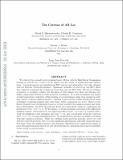| dc.contributor.author | Huenemoerder, David P. | |
| dc.contributor.author | Canizares, Claude R. | |
| dc.contributor.author | Drake, Jeremy J. | |
| dc.date.accessioned | 2013-01-07T21:17:10Z | |
| dc.date.available | 2013-01-07T21:17:10Z | |
| dc.date.issued | 2003-10 | |
| dc.date.submitted | 2003-01 | |
| dc.identifier.issn | 0004-637X | |
| dc.identifier.issn | 1538-4357 | |
| dc.identifier.uri | http://hdl.handle.net/1721.1/76060 | |
| dc.description.abstract | We observed the coronally active eclipsing binary AR Lac with the High Energy Transmission Grating on Chandra for a total of 97 ks, spaced over five orbits, at quadratures and conjunctions. Contemporaneous and simultaneous EUV spectra and photometry were also obtained with the Extreme Ultraviolet Explorer. Significant variability in both X-ray and EUV fluxes were observed, dominated by at least one X-ray flare and one EUV flare. We saw no evidence of primary or secondary eclipses, but exposures at these phases were short and intrinsic variability compromised detection of any geometric modulation. X-ray flux modulation was largest at high temperature, indicative of flare heating of coronal plasma rather than changes in emitting volume or global emission measure. Analysis of spectral line widths interpreted in terms of Doppler broadening suggests that both binary stellar components are active. On the basis of line fluxes obtained from total integrated spectra, we have modeled the emission measure and abundance distributions. The EUV spectral line fluxes were particularly useful for constraining the parameters of the "cool" (≤2 × 10[superscript 6] K) plasma. A strong maximum was found in the differential emission measure, characterized by two apparent peaks at log T = 6.9 and 7.4, together with a weak but significant cooler maximum near log T = 6.2 and a moderately strong hot tail from log T = 7.6-8.2. Coronal abundances have a broad distribution and show no simple correlation with first ionization potential. While the resulting model spectrum generally agrees very well with the observed spectrum, there are some significant discrepancies, especially among the many Fe L lines. Both the emission measure and abundance distributions are qualitatively similar to prior determinations from other X-ray and ultraviolet spectra, indicating some long-term stability in the overall coronal structure. | en_US |
| dc.description.sponsorship | United States. National Aeronautics and Space Administration (Contract NAS 8-38249) | en_US |
| dc.description.sponsorship | United States. National Aeronautics and Space Administration (Contract NAS 8-01129) | en_US |
| dc.description.sponsorship | Smithsonian Astrophysical Observatory (SV1-61010) | en_US |
| dc.description.sponsorship | United States. National Aeronautics and Space Administration (Contract NAS 8-39073) | en_US |
| dc.language.iso | en_US | |
| dc.publisher | IOP Publishing | en_US |
| dc.relation.isversionof | http://dx.doi.org/10.1086/377490 | en_US |
| dc.rights | Article is made available in accordance with the publisher's policy and may be subject to US copyright law. Please refer to the publisher's site for terms of use. | en_US |
| dc.source | arXiv link from Prof. Canizares | en_US |
| dc.title | The Coronae of AR Lac | en_US |
| dc.type | Article | en_US |
| dc.identifier.citation | Huenemoerder, David P. et al. “The Coronae of AR Lacertae.” The Astrophysical Journal 595.2 (2003): 1131–1147. | en_US |
| dc.contributor.department | MIT Kavli Institute for Astrophysics and Space Research | en_US |
| dc.contributor.approver | Canizares, Claude | |
| dc.contributor.mitauthor | Huenemoerder, David P. | |
| dc.contributor.mitauthor | Canizares, Claude R. | |
| dc.relation.journal | Astrophysical Journal | en_US |
| dc.eprint.version | Author's final manuscript | en_US |
| dc.type.uri | http://purl.org/eprint/type/JournalArticle | en_US |
| eprint.status | http://purl.org/eprint/status/PeerReviewed | en_US |
| dspace.orderedauthors | Huenemoerder, David P.; Canizares, Claude R.; Drake, Jeremy J.; Sanz‐Forcada, Jorge | en |
| dc.identifier.orcid | https://orcid.org/0000-0002-5769-8441 | |
| mit.license | PUBLISHER_POLICY | en_US |
| mit.metadata.status | Complete | |
